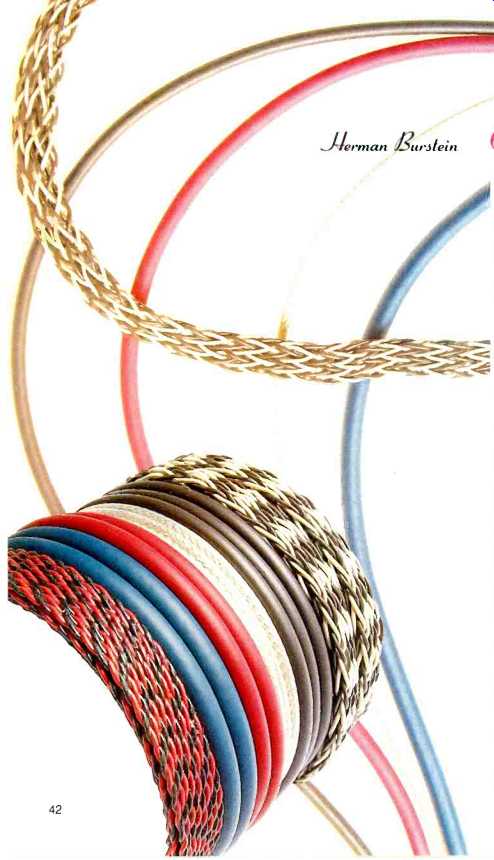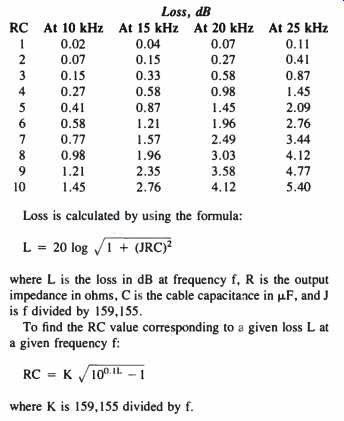
By Herman Burstein
The high end of a newly installed system may sound sweet and smooth, until you find out it's been rolled off by an interaction between component and cable.
Every serious audiophile should be alert to possible treble loss caused by a component's high output impedance or the high capacitance of his interconnect cable. If we let R stand for output impedance in ohms, and let C stand for cable capacitance in uF (microfarads), and then multiply one by the other, the result, RC, will show if there is significant treble loss; we want low RC. What is significant treble loss? Of course, it varies with hearing ability, taste, and quite possibly other factors.
But as a rough guide we may think of good high-end frequency response as being down by no more than 3 dB at 20 kHz (except for FM, which is limited to 15 kHz). Excellent response would be no more than 1 dB down, and purist no more than 0.25 dB down.
Output impedance, which is essentially resistive and therefore called R, is independent of frequency. But capacitive impedance, labeled Xc, declines as frequency rises. Output impedance R and capacitive impedance Xc form a voltage divider across the signal, with the voltage portion across Xc going to the next component in the chain. As frequency rises, Xc declines relative to R so that the voltage across Xc drops, causing treble loss. Thus, at a given frequency, loss is determined by the ratio of R divided by Xc; the smaller this ratio, the smaller the loss. Because Xc varies inversely with cable capacitance C, we may substitute C for 1 divided by Xc and therefore say that the smaller RC is, the smaller the loss will be at a given frequency.
As can be seen in Table I, treble loss is insignificant when RC is 1 or less. Fortunately, the output impedance of tape decks, preamps, CD players, surround sound processors, equalizers, etc., tends to be quite low today, usually under 1 kilohm. (The output impedance of even fairly long interconnects is usually below 0.001 µF.) The resulting RC is usually below 1, and treble response is safe. On the other hand, some components have output impedances of several thousand ohms-as high as 10 kilohms in the case of one passive preamp-and some audiophiles employ unusual or very long cables.
As a "good" scenario, assume a CD player has an output impedance of 200 ohms--quite typical--and that its interconnect to the preamp is a 6-foot, heavy-duty cable whose capacitance is 30 pF (picofarads) per foot. (One picofarad is one-millionth of 1 µF, so to convert pF to µF, we divide pF by 1,000,000.) Accordingly, the cable's capacitance is 180 pF, or 0.00018 µF. Therefore:
RC = 200 x 0.00018 = 0.036.
Treble response is safe indeed! Now, for the opposite scenario. In an actual case, a CD player's output impedance was found to vary with the setting of its output control; it measured as high as 4,475 ohms. Assume that this CD player is fed directly to the power amplifier, located close to the speakers and requiring a 30-foot interconnect (big listening room). Assume further that the cable's capacitance is 50 pF per foot, for a total of 1,500--or 0.0015 µF. (Although conventional shielded cable of high quality typically has capacitance of 25 to 30 pF per foot, the capacitance of some cables, including exotic ones, may be appreciably higher, perhaps as high as 70 pF per foot. Hence 50 pF per foot is not an unreasonable assumption for a bad-case scenario.) In this example, RC could be as great as 6.7125 (the product of 4,475 and 0.0015). As Table I reveals, RC this high produces a loss greater than 2 dB at 20 kHz.
Table I shows loss, in dB, at 10, 15, 20, and 25 kHz for RC values from 1 to 10. To illustrate, if RC is 3, the respective losses at 10, 15, 20, and 25 kHz are 0.152, 0.334, 0.577, and 0.871 dB. (The dB values in the Table have been rounded off.) An RC of 6.7125, as in our example above, produces a loss between 1.96 dB and 2.49 dB at 20 kHz; from the formula at the bottom of the Table, we find the exact loss to be 2.33 dB. At 10 kHz, the loss is 0.71 dB; and at 15 kHz, 1.46 dB, while at 25 kHz, it is 3.25 dB. While a loss such as 2.33 dB at 20 kHz may not seem distressing, it must be recognized that RC losses are additive. If more than two electronic components are in the audio chain, individual RC losses that are not serious in and of themselves may add up to a total that is significant. (Moreover, there can be treble losses within components to be taken into account, possibly adding something on the order of a 1 to 3-dB loss at 20 kHz.)
Summing up, it appears wise to mind not only your Ps and Qs, but also your Rs and Cs.
Table I--Treble loss at selected frequencies for selected RC values.

(source: Audio magazine, Nov. 1991)
Also see:
What Ever Became of Frequency Response? (Jun. 1991)
= = = =